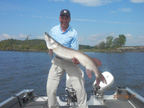
Posts: 3508
Location: Elk River, Minnesota | Hiya,
Jerry is right on phase separation, but I think it is important that we all understand that phase separation only occurs when the fuel in question has reached it's full saturation level of water. In one gallon alone, saturation would occur when you have roughly 3.8 tsp of water at 60 degrees in the fuel and that amount drops to 2.8 in 20 degree temps ....that is not a huge amount per gallon and to be honest, I feel there would need to be an outside source that somehow introduced the water to the system. Now...consider many of our onboard tanks are in excess of 20 gallons or larger....that is a bunch of water intrusion to get in a system, which is not very likely in my humble opinion. Let's say you have a 50 gallon tank with 20 gallons of fuel in it... that would equate to just over 1-1/2 cups of water having to be in the fuel to cause phase separation to happen at 60 degrees and a little over 1 cup for 20 degrees. I just don't feel that is an amount we would see on any regular basis, given we purchase fresh fuel from a reputable establishment that gets a bunch of business before storing our rigs. I don't think any fuel establishment would stay in business with that much water in their tanks at all times.
I would say the separation is highly unlikely since the temperature change from the environment around the tank will be fairly consistent most of the time as well. The tank is not in direct sunlight...usually protected by a layer of plywood (or whatever flooring type your boat has as is the air around it) which insulates it from massive temperature changes quickly. And...as many store their boats inside, they are protected even more so from big temperature changes, or if they store the boat outside, a cover provides another layer of insulating air. So...to generate that much condensation on the inside of a tank would take massive amounts of sitting time, and specific environmental factors to happen consistently.
Also note as Shep stated, consdensation will not happen in a full tank as condensation needs to have empty space to form (it's like the condensation on the outside of a toilet tank which the exterior of the tank is open to air, which would be hotter than the water inside) condensation would not form on the inside of the tank at all...it would form on the outside if temps went up.
So...in winterizing, a full tank is a good thing, and even better in the northern states. our humidity is quite low during the winter months, which will lessen the effect of any condensation potentially forming inside the tank. The temp inside the tank would have to be significantly warmer than the outside temp around the tank, and be a big enough difference in temp and humidity level for it to occur...that is not very likely....especially in our winter months.
If you do your final fill up from a well used fuel station, you will be fine....
Some good reading, there Jerry. You made me go back and research more 
Steve
|





